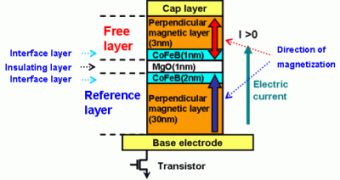The MRAM or Magnetoresistive Random Access Memory is part of a class of non-volatile computer memory (NVRAM) that has been developing ever since the early 1990's. The unique properties of these kinds of memories are thought to make them the dominant used memories in the future.
Instead of using electric charges to store information MRAM uses magnetic storage elements. The Cell Structure is composed of a material with perpendicular magnetic anisotropy to record information and a type of cobalt-iron is used in the magnetic layer, with magnesium oxide in the insulating layer and cobalt-iron-boron in the interface layers.
The reading of the memory is made by measuring the electrical resistance of the cell, therefore measuring the voltage through the cell. The cell is selected to be read through a transistor that switches current from a supply line through the cell to the ground. The electrical resistance appears due to the orientation of the magnetic fields, two plates holding the magnetic charge generated by the magnetic tunnel effect.
The writing of the cells can be made through a variety of ways, the simplest one is by using an induced magnetic field, the toggle mode for multi-step writing or a new technique called spin-torque-transfer. Since it is the simplest way of writing a MRAM memory you would think this is the preferred method, but generating an induced magnetic field requires a strong current, which is not exactly what low-consumption enthusiasts have in mind.
Toshiba has recently announced an important breakthrough in the technology of magnetoresistive random access memory and has fabricated a MRAM memory cell integrating the new technologies and verified its performance.
MRAM is a highly expected product since it combines some of the best features of all the previous memories before it. It is non-volatile, has high random write/read speed similar to the SRAM (Static Random Access Memory), the high density specific to the DRAM but with less power consumption and relatively simple design.
Toshiba uses the spin transfer switching technique to write data to the memory and perpendicular magnetic anisotropy (PMA) in a magnetic tunnel junction. Spin transfer switching harnesses the properties of the electron's quantum momentum, which can be observed when an electron changes its state of energy inside an atom. The advantage of this technology is that it requires very low energies to operate.
Spin transfer switching is being implemented in multiple electronic devices, such as to enhance the capacity of high-density hard drives.

 14 DAY TRIAL //
14 DAY TRIAL //